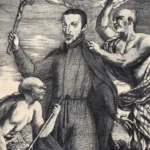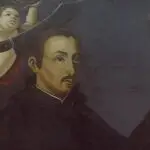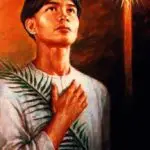Father Diego Luis de San Vitores




Table of Contents
Share This
Marianas evangelist
Father Diego Luis de San Vitores (1627 – 1672), a member of the religious order of the Society of Jesus (Jesuits), brought Christianity to the CHamoru/Chamorro people in 1668. He was killed in Tumon, Guam 2 April 1672 just a little less than four years after his arrival, a death that he welcomed because he would be considered a martyr in his efforts to spread Christianity.
In the latter part of the 17th century, as the fervor of the Spanish empire’s expansionism to gain global and economic power and Christian conversion spread, San Vitores came to Guam and established the first Catholic Church in the Marianas, altering the social, cultural and religious landscape of the 15-island archipelago.
Throughout his missionary efforts, the people the Mariana Islands took part in events that transformed their island into the first permanent European Christian settlement in Oceania. Hagåtña became the first European city after the establishment of colonial government and hosted the beginnings of a European educational system in Guam. The CHamorus survived a massive cultural upheaval as many traditional institutions and cultural practices were eradicated and others adapted to Catholic institutions and Spanish cultural practices.
One of the earliest records of contact with the CHamorus of the Mariana Islands and Europeans was when Ferdinand Magellan’s lost expedition (during its search for the Spice Islands) berthed off Guam’s shores in 1521. Although, Miguel de Legazpi wouldn’t claim the island for the Spanish empire for another 44 years, the Spanish would have no real interest in the islands until 1668, when San Vitores’ five-year-long bid to establish a mission in the Marianas was finally realized.
Early life
San Vitores was the son of a nobleman. He was born Diego Jeronimo de San Vitores on 12 November 1627 in the city of Burgos, Spain to Don Jeronimo San Vitores de Portilla and Dona Maria Alonso Maluenda. Diego Luis de San Vitores entered the Society of Jesus as a novitiate at the age of 13 after having overcome opposition from his parents who wished him to join the military and feared that there would be no other son to carry on the family name as his brother Miguel had died at the age of seven. His parents finally conceded, however, to his wishes and he assured them that they would have several more children.
After becoming a member of the Society of Jesus, he changed his name to Diego Luis de San Vitores as it was the custom of the time to take the name of a saint. On 23 December 1651 San Vitores was ordained a priest in Spain at the age of twenty-four.
Encountering the CHamorus/Chamorros
San Vitores’ first encounter with the CHamorus was in 1662 while he and other missionaries were in transit to the Philippines aboard the Spanish galleon San Damian. The ship made a brief stop at the “Islas de los Ladrones,” or “Islands of Thieves” as the Marianas were known at the time. (The islands received this unfortunate name after Magellan’s lost, starved, and scurvy-ridden convoy landed there in 1521 and a dispute over a skiff led to a deadly attack on the CHamorus. Before the incident occurred, Magellan initially named the islands “Islas de las Velas Latinas” or the “Islands of Lateen Sails,” for the swiftness, agility and maneuverability of the proas that the CHamorus navigated.)
As San Damian pulled into the waters off the island of Guam, San Vitores sighted the CHamorus and felt a great desire to “bring the light of Christianity” to what he interpreted to be Godless islanders. He continued on to his mission in the Philippines, but went to great lengths to find a way to begin a mission in the Marianas. He used his father’s influence as a member of the Spanish Crown Treasury to get the support of Queen Maria Ana de Austria for his way to the islands. In 1665, three years after San Vitores first visited the islands, Spain’s King Philip IV, issued a royal cedula, or royal decree, ordering the missions to begin in the islands.
Despite the court’s endorsement, San Vitores encountered several setbacks from Spanish authorities in the Philippines and Mexico, which oversaw the funding of overseas expeditions in the Pacific region. The resistance was presumably because the expense to bring the missionary to the isolated islands was economically burdensome and would not yield an economic profit. San Vitores was determined, however, to reach the islands and was eventually successful.
In June 1668, the patache (or supply boat) San Diego arrived off the shores of Guam’s primary village, Hagåtña, carrying San Vitores and other missionaries to begin their efforts. For her support, San Vitores renamed the archipelago Islas de Marianas, the Mariana Islands, in honor of Queen Maria Ana. He subsequently renamed the other islands in honor of Saints; Guam was renamed San Juan.
Conversion efforts
The first CHamoru baptized was the infant daughter of a CHamoru mother and a Filipino castaway named Pedro Calungsor who lived in the islands for 30 years after the 1638 shipwreck of the Nuestra Señora de la Concepción off Saipan’s coast. Calungsor became San Vitores’ lay assistant and translator but later ran away from him. After Calungsor left San Vitores the priest returned to the Philippines and found another assistant with, ironically, the same name but who was about 17-years-old. The younger Pedro Calungsor is also often referred to as Calungsod in historical literature.
The first adult CHamoru baptized was Maga’låhi Kepuha (Quipuha) from Hagåtña who gave land for the first Catholic Church, which San Vitores dedicated as Dolce Nombre de Maria, the Sweet Name of Mary. It was located near to where the present-day Dulce Nombre de Maria Cathedral-Basilica stands in Hagåtña.
The CHamorus initially welcomed San Vitores and the other Catholic missionaries and hundreds were readily converted. The nobles of the community may have believed this would elevate their social status while others village elders desired priests for their own village, probably as symbols of status. Some islanders apparently also received the sacrament of baptism more than once for the gifts of beads and clothing they were given.
This enthusiasm for Catholicism did not last long, however, as several factors quickly came into play including the conflicts it created in the hierarchal caste system of the CHamorus. The church preached that once baptized, people were equal in the eyes of God. The missionary’s dogmatic zeal was also not well received as the Jesuits shunned long-standing traditional beliefs and practices in trying to assimilate the CHamorus in Christian doctrine. This included the rejection of the CHamorus long standing veneration of ancestors. As part of the religious practices of CHamoru culture, people had the skulls of deceased family members placed in baskets in places of honor in their homes. The CHamorus believed that this allowed their deceased to have a place to stay and often sought the guidance of their ancestors and favors from them in their daily endeavors.
The missionaries told the CHamorus that their ancestors (including parents and grandparents) were burning in hell because they had not been baptized as Christians. The Christian missionaries also looked down upon and ordered the burning and destruction of Guma’ Uritao (men’s houses) because of what was considered institutionalized prostitution. Boys lived in the Guma’ Uritao after they reached puberty to learn the life skills they would need as men such as canoe building, navigating, tool making and fishing. CHamorus believed that learning about sex was also a valuable skill for youth. The women who taught the uritaos (bachelors) about sex were not forced to live in the Guma’ Uritaos, however, and it was considered honorable to become a ma’ uritao. Men would leave the men’s houses and, usually, remained married to one woman.
The social and cultural importance of the Guma’ Uritao was lost to the missionaries who remained fixated on what they perceived to be sinful acts in the Guma’ Uritao. To counter this form of accepted “cultural education,” San Vitores created the beginnings of a colonial educational system by establishing the Colegio San Juan de Letran in 1669, a seminary for boys; and later a school for girls, Escuela de Ninas.
The tide of discontent continued with the missionaries’ presence. For whatever reason, profit or pride, historical documents pinpoint a Chinese man named Choco, who was living in Guam for about two decades after he was shipwrecked in the Marianas prior to the missionaries’ arrival, as having been the instigator of rumors that would have negative ramifications for the missionaries.
Choco was married to a CHamoru woman from Saipan, and living in the southern village of Pa’a (which has now disappeared in present-day Guam). Choco came to the Marianas when the boat he and other Chinese men sailing from the Philippines shipwrecked.
Choco promoted the rumor that the baptismal water and anointing oils used in religious rites were killing people, thwarting conversion efforts so much that San Vitores would eventually end up confronting Choco at Pa’a. The two were locked into in a days-long public debate (in Chamorro) about religion with Choco supposedly conceding and even receiving baptism, but it did not take long for him to renounce Catholicism.
Martyrdom
The murder or San Vitores and his assistant occurred at the height of a circulation of Choco’s rumors and festering animosity between the CHamorus and the missionaries. San Vitores and Pedro Calungsor were killed in Tumon on 2 April 1672 after he baptized the infant daughter of Maga’låhi Mata’pang of Tumon, who was once a Christian convert, without his consent. Mata’pang believed the baptismal waters would kill his child. When Mata’pang discovered San Vitores’ actions he enlisted a warrior, Hirao, to kill San Vitores.
Despite San Vitores’ death, evangelization continued even more aggressively at the expense of the lives of CHamorus and some Spaniards. Defiant CHamorus did not acquiesce to colonial forces, but were eventually subdued by the colonizers’ advanced weaponry. Their plans to rid the island of the Spaniards were thwarted, too, by CHamorus who had chosen Christianity and who defended the Spanish against attacks.
CHamorus from throughout Marianas were forced to relocate to Guam and Rota to live in Spanish-style villages with a Catholic church as a focal point, and forced to abandon traditional ways of life such as seafaring.
Quest for Sainthood
Today Catholicism is the leading religion in Guam and throughout the Mariana Islands. There is a monument in Tumon, near the site of San Vitores’ death, showing the priest baptizing the chief’s daughter as Mata’pang stands behind him lifting a sword ready to strike the priest. Hirao is also behind he priest while Mata’pang’s wife kneels watching her daughter being baptized.
The Catholic Church in the Marianas, now led by CHamoru priests, has spearheaded efforts to have San Vitores recognized as a saint. This effort was begun by the first CHamoru bishop, Felixberto C. Flores, who was later elevated to archbishop. San Vitores was beatified along with his assistant, Pedro Calangsod, in 1985.
For further reading
García, Francisco. The Life and Martyrdom of Diego Luis de San Vitores, S.J. Translated by Margaret M. Higgins, Felicia Plaza, and Juan M.H. Ledesma. Edited by James A. McDonough. MARC Monograph Series 3. Mangilao: Micronesian Area Research Center, University of Guam, 2004.
Hezel, Francis X., SJ. “Journey of Faith: Blessed Diego of the Marianas.” Micronesian Seminar. Last modified 8 May 2019.
Johnston, Emilie G., ed. Father San Vitores: His Life, Times, and Martyrdom. MARC Publications Series 6. Mangilao: Richard F. Taitano Micronesian Area Research Center, University of Guam, 1993.
Lévesque, Rodrigue. History of Micronesia: A Collection of Source Documents. Vol. 6, Revolts in the Marianas, 1673-1678. Québec: Lévesque Publications, 1995.
Risco, Alberto, SJ. The Apostle of the Marianas: The Life, Labors, and Martyrdom of Ven. Diego Luis de San Vitores, 1627-1672. Translated by Juan M.H. Ledesma, SJ and edited by Msgr. Oscar L. Calvo. Hagåtña: Diocese of Agana, 1970.
